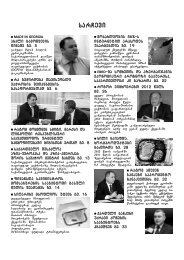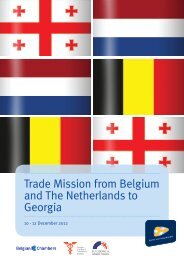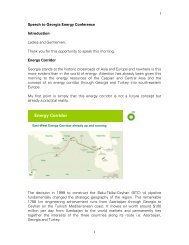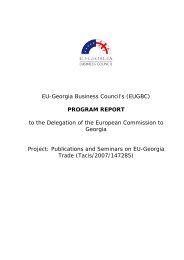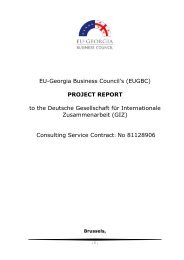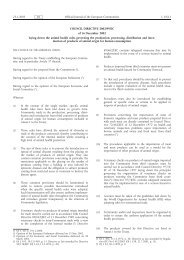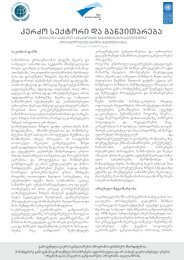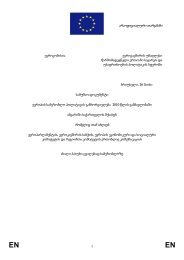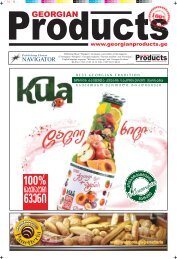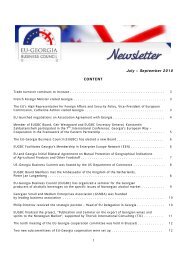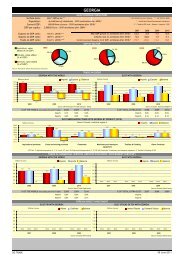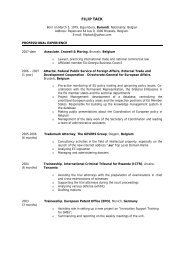Council Directive 91-493-EEC.pdf - EUGBC
Council Directive 91-493-EEC.pdf - EUGBC
Council Directive 91-493-EEC.pdf - EUGBC
You also want an ePaper? Increase the reach of your titles
YUMPU automatically turns print PDFs into web optimized ePapers that Google loves.
COUNCIL DIRECTIVE<br />
of 22 July 19<strong>91</strong><br />
laying down the health conditions for the production and the placing<br />
on the market of fishery products<br />
<strong>91</strong>/<strong>493</strong>/<strong>EEC</strong><br />
incorporated by 94/103(51) (OJ No. Nr. L 001 v. 03.01.94 p. 220)<br />
amended by 94/356/<strong>EEC</strong> (OJ No. L 156 v. 23.06.94 p. 50)<br />
amended by ACT of 1994<br />
amended by <strong>Directive</strong> 95/71/EC (OJ No. L 332 v. 30.12.95 p. 40)<br />
See <strong>Directive</strong> 96/23/EC (OJ No. L 125 v. 23.5.96 p. 10)<br />
amended by <strong>Directive</strong> 97/79/EC (OJ No. L 24 v. 30.1.98 p. 31)<br />
THE COUNCIL OF THE EUROPEAN COMMUNITIES,<br />
Having regard to the Treaty establishing the European Economic Community,<br />
and in particular Article 43 thereof,<br />
Having regard to the proposals from the Commission,<br />
Having regard to the opinions of the European Parliament,<br />
Having regard to the opinions of the Economic and Social Committee,<br />
Whereas, with a view to achieving the internal market and more especially to<br />
ensuring the smooth operation of the common organization of the market in<br />
fishery products established by Regulation (<strong>EEC</strong>) No 3796/81, as last<br />
amended by Regulation (<strong>EEC</strong>) No 2886/89, it is essential that the marketing<br />
of fish and fish products should no longer be hindered by disparities existing<br />
in the Member States in respect of health requirements; whereas this will enable<br />
production and placing on the market to be better harmonized and bring<br />
about competition on equal terms, whilst ensuring quality products for the<br />
consumer;<br />
Whereas the European Parliament in its legislative resolution of 17 March<br />
1989 requested the Commission to come forward with comprehensive proposals<br />
on the hygienic production and placing on the market of fishery products,<br />
including solutions for the problem of nematodes;
Whereas fishery products freshly caught are in principle free of contamination<br />
with micro-organisms; whereas however contamination and subsequent<br />
decomposition may occur when handled and treated unhygienically;<br />
Whereas therefore the essential requirements should be laid down for the<br />
correct hygienic handling of fresh and processed fishery products at all<br />
stages of production and during storage and transport;<br />
Whereas it is appropriate to apply by analogy certain marketing standards<br />
which are laid down pursuant to Article 2 of Regulation (<strong>EEC</strong>) No 3796/81, in<br />
order to fix the health quality of these products;<br />
Whereas it is the responsibility primarily of the fisheries industry to ensure<br />
that fishery products meet the health requirements laid down in this <strong>Directive</strong>;<br />
Whereas the competent authorities of the Member States must, by carrying<br />
out checks and inspections, ensure that producers and manufacturers comply<br />
with the said requirements;<br />
Whereas Community control measures should be introduced to guarantee<br />
the uniform application in all Member States of the standards laid down in this<br />
<strong>Directive</strong>;<br />
Whereas, in order to ensure the smooth operation of the internal market, the<br />
measures should apply in an identical manner to trade within the Member<br />
States and to trade between the Member States;<br />
Whereas in the context of intra-Community trade, the rules laid down in<br />
<strong>Council</strong> <strong>Directive</strong> 89/662/<strong>EEC</strong> of 11 December 1989 concerning veterinary<br />
checks in intra-Community trade with a view to the completion of the internal<br />
market as amended by <strong>Directive</strong> 90/675/<strong>EEC</strong> (Note by MediaLex: since 1<br />
July 1999, <strong>Council</strong> <strong>Directive</strong> 97/78/EC, of 18.12.1997)apply to fishery products;<br />
Whereas fishery products from third countries intended to be placed on the<br />
market of the Community must not qualify for more favourable arrangements<br />
than those applied in the Community; whereas provision should therefore be<br />
made for a Community procedure for the inspection in third countries of the<br />
conditions of production and placing on the market in order to permit the application<br />
of a common import system based on conditions of equivalence;<br />
Whereas the products in question are subject to the rules concerning checks<br />
and to safeguard measures covered by <strong>Council</strong> <strong>Directive</strong> 90/675/<strong>EEC</strong> (Note
y MediaLex: since 1 July 1999, <strong>Council</strong> <strong>Directive</strong> 97/78/EC, of<br />
18.12.1997)of 10 December 1990 laying down the principles governing the<br />
organization of veterinary checks on products entering the Community from<br />
third countries;<br />
Whereas, so that account may be taken of particular circumstances, derogations<br />
should be granted to some establishments already operating before 1<br />
January 1993 so as to allow them to adapt to all the requirements laid down<br />
in this <strong>Directive</strong>;<br />
Whereas the Commission should be entrusted with the task of adopting<br />
certain measures for implementing this <strong>Directive</strong>; whereas, to that end, procedures<br />
should be laid down introducing close and effective co-operation<br />
between the Commission and the Member States within the Standing Veterinary<br />
Committee;<br />
Whereas the essential requirements laid down in this <strong>Directive</strong> may need<br />
further specification,<br />
HAS ADOPTED THIS DIRECTIVE<br />
CHAPTER I<br />
General provisions<br />
Article 1<br />
This <strong>Directive</strong> lays down the health conditions for the production and the<br />
placing on the market of fishery products for human consumption.<br />
Article 2<br />
For the purposes of this <strong>Directive</strong>, the following definitions shall apply:<br />
1. 'fishery products' means all seawater or freshwater animals or parts<br />
thereof, including their roes, excluding aquatic mammals, frogs and<br />
aquatic animals covered by other Community acts;<br />
2. 'aquaculture products' means all fishery products born and raised in<br />
controlled conditions until placed on the market as a foodstuff. However<br />
seawater or freshwater fish or crustaceans caught in their natural environment<br />
when juvenile and kept until they reach the desired commercial<br />
size for human consumption are also considered to be aquaculture
products. Fish and crustaceans of commercial size caught in their natural<br />
environment and kept alive to be sold at a later date are not considered<br />
to be aquaculture products if they are merely kept alive without any<br />
attempt being made to increase their size or weight;<br />
3. 'chilling' means the process of cooling fishery products to a temperature<br />
approaching that of melting ice;<br />
4. 'fresh products' means any fishery product whether whole or prepared,<br />
including products packaged under vacuum or in a modified atmosphere,<br />
which have not undergone any treatment to ensure preservation<br />
other than chilling;<br />
5. 'prepared products' means any fishery product which has undergone an<br />
operation affecting its anatomical wholeness, such as gutting, heading,<br />
slicing, filleting, chopping, etc.;<br />
6. 'processed products' means any fishery product which has undergone a<br />
chemical or physical process such as the heating, smoking, salting, dehydration<br />
or marinating, etc., of chilled or frozen products, whether or not<br />
associated with other foodstuffs, or a combination of these various processes;<br />
7. 'preserve' means the process whereby products are packaged in hermetically<br />
sealed containers and subjected to heat treatment to the extent<br />
that any micro-organisms that might proliferate are destroyed or inactivated,<br />
irrespective of the temperature at which the product is to be<br />
stored;<br />
8. 'frozen products' means any fishery product which has undergone a<br />
freezing process to reach a core temperature of -18 o C or lower after<br />
temperature stabilization;<br />
9. 'packaging' means the procedure of protecting fishery products by a<br />
wrapper, a container or any other suitable device;<br />
10. 'batch' means the quantity of fishery products obtained under practically<br />
identical circumstances;<br />
11. 'consignment' means the quantity of fishery products bound for one or<br />
more customers in the country of destination and conveyed by one<br />
means of transport only;
12. 'means of transport' means those parts set aside for goods in automobile<br />
vehicles, rail vehicles and aircraft, the holds of vessels, and containers<br />
for transport by land, sea or air;<br />
13. 'competent authority' means the central authority of a Member State<br />
competent to carry out veterinary checks or any authority to which it has<br />
delegated that competence;<br />
14. 'establishment' means any premises where fishery products are prepared,<br />
processed, chilled, frozen, packaged or stored. Auction and<br />
wholesale markets in which only display and sale by wholesale takes<br />
place are not deemed to be establishments;<br />
15. 'placing on the market' means the holding or displaying for sale, offering<br />
for sale, selling, delivering or any other form of placing on the market in<br />
the Community, excluding retail sales and direct transfers on local markets<br />
of small quantities by fishermen to retailers or consumers, which<br />
must be subject to the health checks laid down by national rules for<br />
checking the retail trade;<br />
16. 'importation' means the introduction into the territory of the Community of<br />
fishery products from third countries;<br />
17. 'clean seawater' means seawater or briny water which is free from microbiological<br />
contamination, harmful substances and/or toxic marine<br />
plankton in such quantities as may affect the health quality of fishery<br />
products and which is used under the conditions laid down in this <strong>Directive</strong>;<br />
18. 'factory vessel' means any vessel on which fishery products undergo<br />
one or more of the following operations followed by packaging: filleting,<br />
slicing, skinning, mincing, freezing or processing.<br />
The following are not deemed to be 'factory vessels':<br />
- fishing vessels in which only shrimps and molluscs are cooked on<br />
board;<br />
- fishing vessels on board which only freezing is carried out.<br />
Article 3<br />
1. The placing on the market of fishery products caught in their natural environment<br />
shall be subject to the following conditions:
(a) they must have:<br />
(i) been caught and where appropriate handled for bleeding,<br />
heading, gutting and the removal of fins, chilled or frozen, on<br />
board vessels in accordance with hygiene rules to be established<br />
by the <strong>Council</strong> acting by a qualified majority on a proposal<br />
from the Commission. The Commission shall submit<br />
proposals to that effect before 1 October 1992;<br />
(ii) where appropriate, been handled in factory vessels approved<br />
in accordance with Article 7, and in accordance with the requirements<br />
of Chapter I of the Annex.<br />
The cooking of shrimps and molluscs on board must comply<br />
with the provisions of Chapter III, section I(5) and Chapter IV,<br />
section IV(7), of the Annex. Such vessels shall be specifically<br />
registered by the competent authorities;`<br />
(b) during and after landing they must have been handled in accordance<br />
with Chapter II of the Annex;<br />
(c) they must have been handled and, where appropriate, packaged,<br />
prepared, processed, frozen, defrosted or stored hygienically in<br />
establishments approved in accordance with Article 7, in compliance<br />
with the requirements of Chapters III and IV of the Annex.<br />
The competent authority may, notwithstanding Chapter II, section 2<br />
of the Annex, authorize the transfer of fishery products ex quay into<br />
containers for immediate delivery to an approved establishment or<br />
registered auction or wholesale market to be checked there;<br />
(d) they must have undergone a health check in accordance with<br />
Chapter V of the Annex;<br />
(e) they must have been appropriately packaged in accordance with<br />
Chapter VI of the Annex;<br />
(f) they must have been given an identification mark in accordance with<br />
Chapter VII of the Annex;<br />
(g) they must have been stored and transported under satisfactory<br />
conditions of hygiene, in accordance with Chapter VIII of the Annex.
2. Where gutting is possible from a technical and commercial viewpoint, it<br />
must be carried out as quickly as possible after the products have been<br />
caught or landed.<br />
3. The placing on the market of aquaculture products shall be subject to<br />
the following conditions:<br />
(a) they must have been slaughtered under appropriate conditions of<br />
hygiene. They must not be soiled with earth, slime or faeces. If not<br />
processed immediately after having been slaughtered, they must<br />
be kept chilled;<br />
(b) they must, in addition, comply with the requirements laid down under<br />
1 (c) to (g).<br />
4(a) The placing on the market of live bivalve molluscs shall be subject<br />
to the requirements laid down in <strong>Council</strong> <strong>Directive</strong> <strong>91</strong>/492/<strong>EEC</strong> of<br />
15 July 19<strong>91</strong> laying down the health conditions for the production<br />
and the placing on the market of live bivalve molluscs.<br />
(b) When processed, bivalve molluscs must, in addition to the requirements<br />
in point (a), satisfy those of paragraph 1 (c) to (g).<br />
Article 4<br />
Fishery products to be placed on the market alive shall at all times be kept<br />
under the most suitable survival conditions.<br />
Article 5<br />
The placing on the market of the following products shall be forbidden:<br />
- poisonous fish of the following families: Tetraodontidae, Molidae, Diodontidae,<br />
Canthigasteridae,<br />
- fishery products containing biotoxins such as ciguatera toxins or muscle-paralysing<br />
toxins.<br />
Detailed requirements concerning the species covered by this Article and<br />
concerning methods of analysis shall be laid down in accordance with the<br />
procedure prescribed in Article 15.
Article 6<br />
1. Member States shall ensure that persons responsible for establishment<br />
take all necessary measures, so that, at all stages of the production of<br />
fishery products, the specifications of this <strong>Directive</strong> are complied with.<br />
To that end, the said persons responsible must carry out their own<br />
checks based on the following principles;<br />
- identification of critical points in their establishment on the basis of<br />
the manufacturing processes used;<br />
- establishment and implementation of methods for monitoring and<br />
checking such critical points;<br />
- taking samples for analysis in an approved laboratory by the competent<br />
authority for the purpose of checking cleaning and disinfection<br />
methods and for the purpose of checking compliance with the<br />
standards established by this <strong>Directive</strong>;<br />
- keeping a written record or a record registered in an indelible fashion<br />
of the preceding points with a view to submitting them to the<br />
competent authority. The results of the different checks and tests<br />
will in particular be kept for a period of at least two years.<br />
2. If the results of own checks or any information at the disposal of the<br />
persons responsible referred to in paragraph 1 reveal the risk of a health<br />
risk or suggest one might exist and without prejudice to the measures<br />
laid down in the fourth subparagraph of Article 3 (1) of <strong>Directive</strong><br />
89/662/<strong>EEC</strong>, the appropriate measures shall be taken, under official supervision.<br />
3. Rules for the application of the second subparagraph of paragraph 1<br />
shall be established in accordance with the procedure laid down in Article<br />
15.<br />
Article 7<br />
1. The competent authorities shall approve establishments once they have<br />
verified that these establishments meet the requirements of this <strong>Directive</strong>,<br />
with regard to the nature of the activities they carry out. The approval<br />
must be renewed if an establishment decides to carry out activities<br />
other than those for which it has received approval.
The competent authorities shall take the necessary measures if the requirements<br />
cease to be met. To this end, they shall take particular account<br />
of the conclusions of any check carried out in accordance with Article<br />
8.<br />
The competent authority shall register those auction and wholesale markets<br />
which are not subject to approval after verifying that such installations<br />
comply with the provisions of this <strong>Directive</strong>.<br />
2. However, subject to the express condition that products coming from<br />
factory-vessels and establishments, auction and wholesale markets<br />
meet the hygiene standards set by this <strong>Directive</strong>, Member States may,<br />
for the requirements relating to equipment and structures laid down in<br />
Chapters I to IV to the Annex, grant to factory-vessels and establishments,<br />
auction and wholesale markets a further period expiring on 31<br />
December 1995, except for Finland, where the date to be adopted shall<br />
be 31 December 1997, within which to comply with the conditions of<br />
approval set out in Chapter IX. Such derogations may be granted only to<br />
factory-vessels and establishments, auction and wholesale markets, already<br />
operating on 31 December 1992, which have, before 1 July 1993,<br />
submitted a duly justified application for derogation to the competent<br />
national authority. This application must be accompanied by a work plan<br />
and program indicating the period within which it would be possible for<br />
them to comply with the requirements in question. Where financial assistance<br />
is requested from the Community, only requests in respect of<br />
projects complying with the requirements of this <strong>Directive</strong> can be accepted.<br />
3. The competent authorities shall draw up a list of their approved establishments,<br />
each of which shall have an official number.<br />
Each Member State shall notify the Commission of its list of approved<br />
establishments and of any subsequent amendment thereof.<br />
The Commission shall forward this information to the other Member<br />
States.<br />
4. The inspection and monitoring of establishments shall be carried out<br />
regularly under the responsibility of the competent authority, which shall<br />
at all times have free access to all parts of establishments, in order to<br />
ensure compliance with the requirements of this <strong>Directive</strong>.
If such inspections and monitoring reveal that the requirements of this<br />
<strong>Directive</strong> are not being met, the competent authority shall take appropriate<br />
action.<br />
5. Paragraphs 1, 3 and 4 shall also apply in respect of factory vessels.<br />
6. Paragraphs 3 and 4 shall also apply to wholesale and auction markets.<br />
Article 8<br />
1. Experts from the Commission may, in co-operation with the competent<br />
authorities of the Member States, make on-the-spot checks insofar as<br />
this is necessary to ensure the uniform application of this <strong>Directive</strong>. They<br />
may in particular verify whether establishments are in effect complying<br />
with the requirements of this <strong>Directive</strong>. A Member State in whose territory<br />
a check is being carried out shall give all necessary assistance to<br />
the experts in carrying out their duties. The Commission shall inform the<br />
Member States of the results of the investigations.<br />
2. The arrangements for implementing paragraph 1 shall be adopted in accordance<br />
with the procedure laid down in Article 15.<br />
Shall not apply.<br />
Article 9<br />
CHAPTER II<br />
Imports from third countries<br />
Article 10<br />
Provisions applied to imports of fishery products from third countries shall be<br />
at least equivalent to those governing the production and placing on the market<br />
of Community products.<br />
Fishery products caught in their natural environment by a fishing vessel flying<br />
the flag of a third country must undergo the checks laid down in Article 19 (2)<br />
of <strong>Directive</strong> 97/78/<strong>EEC</strong>.
Article 11<br />
1. For each third country or group of third countries, fishery products must<br />
fulfil the specific import conditions fixed in accordance with the procedure<br />
laid down in Article 15, depending on the health situation in the third<br />
country concerned.<br />
2. In order to allow the import conditions to be fixed, and in order to verify<br />
the conditions of production, storage and dispatch of fishery products<br />
for consignment to the Community, inspections may be carried out on<br />
the spot by experts from the Commission and the Member States.<br />
The experts of the Member States who are to be entrusted with these<br />
inspections shall be appointed by the Commission acting on a proposal<br />
from the Member States.<br />
These inspections shall be made on behalf of the Community, which<br />
shall bear any expenditure incurred.<br />
The frequency of and procedure for these inspections shall be determined<br />
in accordance with the procedure laid down in Article 15.<br />
3. When fixing the import conditions of fishery products referred to in<br />
paragraph 1, particular account shall be taken of:<br />
(a) the legislation of the third country;<br />
(b) the organization of the competent authority of the third country and<br />
of its inspection services, the powers of such services and the supervision<br />
to which they are subject, as well as their facilities for effectively<br />
verifying the implementation of their legislation in force;<br />
(c) the actual health conditions during the production, storage and dispatch<br />
of fishery products intended for the Community;<br />
(d) the assurances which a third country can give on the compliance<br />
with the standards laid down in Chapter V of the Annex.<br />
4. The import conditions referred to in paragraph 1 shall include:<br />
(a) the procedure for obtaining a health certificate which must accompany<br />
consignments when forwarded to the Community;<br />
(b) the placing of a mark identifying the fishery products, in particular<br />
with the approval number of the establishment of origin, except in
the case of frozen fishery products, landed immediately for canning<br />
and bearing the certificate provided for under (a);<br />
(c) drawing up a list of approved establishments and auction or wholesale<br />
markets registered and approved by the Commission in accordance<br />
with the procedure laid down in Article 15;<br />
For that purpose, one or more lists of such establishments shall<br />
draw up on the basis of a communication from the competent<br />
authorities of the third country to the Commission. An establishment<br />
may not appear on a list unless it is officially approved by the competent<br />
authority of the third country exporting to the Community.<br />
Such approval shall be subject to observance of the following requirements:<br />
- compliance with requirements equivalent to those laid down in<br />
this <strong>Directive</strong>,<br />
- monitoring by an official inspection service of the third country.<br />
5. The conditions referred to in paragraph 4 (a) and (b) may be modified in<br />
accordance with the procedure laid down in Article 15.<br />
The list referred to in paragraph 4 (c) may be amended by the Commission,<br />
in accordance with the rules established by Commission Decision<br />
90/13/<strong>EEC</strong>.<br />
6. To deal with specific situations and in accordance with the procedure<br />
laid down in Article 15, imports may be authorized direct from an establishment<br />
or factory vessel of a third country where the latter is unable to<br />
provide the guarantees laid down in paragraph 3, provided that the establishment<br />
or factory vessel in question has received special approval<br />
following an inspection carried out in accordance with paragraph (2). The<br />
authorization decision shall fix the specific import conditions to be followed<br />
for products coming from that establishment or factory vessel.<br />
7. Pending the fixing of the import conditions referred to in paragraph 1,<br />
the Member States shall ensure that the conditions applied to imports of<br />
fishery products from third countries shall be at least equivalent to those<br />
governing the production and placing on the market of Community products.
Article 12<br />
1. The rules and principles laid down by <strong>Directive</strong> 90/675/<strong>EEC</strong> (Note by<br />
MediaLex: since 1 July 1999, <strong>Council</strong> <strong>Directive</strong> 97/78/EC, of<br />
18.12.1997)shall apply, notably as regards the organization of and follow<br />
up to the inspections to be carried out by the Member States.<br />
2. deleted by Dir. 97/79/EC<br />
CHAPTER III<br />
Final provisions<br />
Article 13<br />
The Annexes shall be amended by the <strong>Council</strong>, acting by a qualified majority<br />
on a proposal from the Commission.<br />
Article 14<br />
The Commission, after consulting the Member States, shall by 1 July 1992<br />
submit a report to the <strong>Council</strong> concerning the minimum structural and equipment<br />
requirements to be met by small establishments which distribute on the<br />
local market and are situated in regions subject to particular supply constraints,<br />
together with any proposals, on which the <strong>Council</strong>, acting under the<br />
voting procedure laid down in Article 43 of the Treaty, shall act before 31<br />
December 1992.<br />
Article 15<br />
1. Where the procedure laid down in this Article is to be followed, the<br />
Chairman shall refer the matter to the Standing Veterinary Committee<br />
set up by Decision 68/361/<strong>EEC</strong> hereafter referred to as the Committee,<br />
either on his own initiative or at the request of a Member State.<br />
2. The representative of the Commission shall submit to the committee a<br />
draft of the measures to be taken. The committee shall deliver its opinion<br />
on the draft within a time limit which the chairman may lay down according<br />
to the urgency of the matter. The opinion shall be delivered by<br />
the majority laid down in Article 148 (2) of the Treaty in the case of decisions<br />
which the <strong>Council</strong> is required to adopt on a proposal from the<br />
Commission. The votes of the representatives of the Member States
within the committee shall be weighted in the manner set out in that Article.<br />
The chairman shall not vote.<br />
3 (a) The Commission shall adopt the measures envisaged if they are in<br />
accordance with the opinion of the committee.<br />
(b) If the measures envisaged are not in accordance with the opinion of<br />
the committee, or if no opinion is delivered, the Commission shall,<br />
without delay, submit to the <strong>Council</strong> a proposal relating to the<br />
measures to be taken. The <strong>Council</strong> shall act by a qualified majority.<br />
If, on the expiry of a period of three months from the date of referral<br />
to the <strong>Council</strong>, the <strong>Council</strong> has not acted, the proposed measures<br />
shall be adopted by the Commission, save where the <strong>Council</strong> has<br />
decided against the said measures by a simple majority.<br />
Article 16<br />
In order to take into account the possible failure to take a decision on the<br />
detailed rules for applying this <strong>Directive</strong> by 1 January 1993, necessary transitional<br />
measures may be adopted in accordance with the procedure laid<br />
down in Article 15 for a period of two years.<br />
Article 17<br />
The provisions of this <strong>Directive</strong> shall be re-examined before 1 January 1998<br />
by the <strong>Council</strong>, acting on proposals from the Commission, on the basis of<br />
experience gained.<br />
Article 18<br />
The Member States shall bring into force the laws, regulations and administrative<br />
provisions necessary to comply with this <strong>Directive</strong> before 1 January<br />
1993. They shall notify the Commission thereof. When Member States adopt<br />
these measures, they shall contain a reference to this <strong>Directive</strong> or shall be<br />
accompanied by such reference on the occasion of their official publication.<br />
The methods of making such a reference shall be laid down by the Member<br />
States.<br />
Article 19<br />
This <strong>Directive</strong> is addressed to the Member States.
Done at Brussels, 22 July 19<strong>91</strong>.
ANNEX<br />
CHAPTER I<br />
CONDITIONS APPLICABLE TO FACTORY VESSELS<br />
I. Conditions concerning design and equipment<br />
1. The minimum requirements for factory vessels are as follows:<br />
(a) a reception area set aside for taking fishery products on board, designed and arranged into pounds<br />
or pens that are large enough to allow each successive catch to be separated. The reception area<br />
and its movable parts must be easy to clean. It must be designed in such a way as to protect the<br />
products from the sun or the elements and from any source of dirt or contamination;<br />
(b) a system for conveying fishery products from the reception area to the work area that conforms<br />
with rules of hygiene;<br />
(c) work areas that are large enough for the preparation and processing of fishery products in proper<br />
conditions of hygiene. They must be designed and arranged in such a way as to prevent any contamination<br />
of the products;<br />
(d) storage areas for the finished products that are large enough and designed so that they are easy<br />
to clean. If a waste processing unit operates on board, a separate hold must be designated for the<br />
storage of these by-products;<br />
(e) a place for storing packaging materials that is separate from the product preparation and processing<br />
areas;<br />
(f) special equipment for pumping waste or fishery products that are unfit for human consumption either<br />
directly into the sea or, where circumstances so require, into a watertight tank reserved for<br />
that purpose. If waste is stored and processed on board with a view to cleaning, separate areas<br />
must be allocated for that purpose;<br />
(g) equipment providing a supply of potable water within the meaning of <strong>Council</strong> <strong>Directive</strong> 80/778/<strong>EEC</strong><br />
of 15 July 1980 relating to the quality of water intended for human consumption or pressurized<br />
clean seawater. The seawater intake must be situated in a position where it is not possible for the<br />
water being taken in to be affected by discharges into the sea of waste water, waste and engine<br />
coolant outlets;<br />
(h) a suitable number of changing rooms, wash basins and toilets, the latter not opening directly onto<br />
areas where fishery products are prepared, processed or stored. The wash basins must be<br />
equipped with appliances for washing and drying the hands that comply with hygiene requirements;<br />
the wash-basin taps must not be hand-operable.<br />
2. Areas used for the preparation and processing or freezing/quick-freezing of fishery products must have:<br />
(a) a non-slip floor that is also easy to clean and disinfect and equipped for easy drainage of water.<br />
Structures and fixtures must have limber holds that are large enough not to be obstructed by fish<br />
waste and to allow water to drain freely;<br />
(b) walls and ceilings that are easy to clean, particularly where there are pipes, chains or electricity<br />
conduits;<br />
(c) the hydraulic circuits must be arranged or protected in such a way as to ensure that it is not possible<br />
for any leakage of oil to contaminate fishery products;<br />
(d) adequate ventilation and, where necessary, proper vapour extraction;<br />
(e) adequate lighting;<br />
(f) appliances for cleaning and disinfecting tools, equipment and fittings;<br />
(g) appliances for cleaning and disinfecting the hands with taps that are not hand-operable and with<br />
single use towels.<br />
3. Equipment and tools such as cutting benches, containers, conveyors, gutting or filleting machines, etc.,<br />
must be resistant to seawater corrosion, easy to clean and disinfect and well-maintained.<br />
4. Factory vessels which freeze fishery products must have:
(a) a refrigeration plant sufficiently powerful to lower the temperature rapidly so as to achieve a core<br />
temperature that complies with the specifications of this <strong>Directive</strong>;<br />
(b) refrigeration plants sufficiently powerful to keep fishery products in the storage holds at a temperature<br />
that complies with the specifications of this <strong>Directive</strong>. The storage holds must be equipped<br />
with a temperature recording system placed so that it can easily be consulted.<br />
II. Conditions of hygiene relating to on-board handling and storage of fishery products<br />
1. A qualified person on board the factory vessel must be responsible for applying good fishery products<br />
manufacturing practices. That person shall have the authority to ensure that the provisions of this <strong>Directive</strong><br />
are applied and shall make available to inspectors the program for inspecting and checking critical<br />
points as applied on board, a register containing that person's comments and the temperature recordings<br />
that may be required.<br />
2. The general conditions of hygiene applicable to areas and equipment shall be those laid down in Chapter<br />
III, section II (A), of this Annex.<br />
3. The general conditions of hygiene applicable to staff shall be those laid down in Chapter III, section II (B),<br />
of this Annex.<br />
4. Heading, gutting and filleting must be carried out under the conditions of hygiene laid down in Chapter IV,<br />
section I (2), (3) and (4) of this Annex.<br />
5. On-board processing of fishery products must be carried out under the conditions of hygiene laid down<br />
in Section II, points 2 and 3, Section IV and Section V of Chapter IV of this Annex.'<br />
6. Fishery products must be wrapped and packaged under the conditions of hygiene laid down in Chapter<br />
VI of this Annex.<br />
7. On-board storage of fishery products must be carried out under the conditions of hygiene laid down in<br />
Chapter VIII, points 1 and 2, of this Annex.<br />
CHAPTER II<br />
REQUIREMENTS DURING AND AFTER LANDING<br />
1. Unloading and landing equipment must be constructed of material which is easy to clean and disinfect<br />
and must be kept in a good state of repair and cleanliness.<br />
2. During unloading and landing, contamination of fishery products must be avoided. It must in particular be<br />
ensured that:<br />
- unloading and landing operations proceed rapidly;<br />
- fishery products are placed without unnecessary delay in a protected environment at the temperature<br />
required on the basis of the nature of the product and, where necessary, in ice in transport,<br />
storage or market facilities, or in an establishment;<br />
- equipment and handling practices that cause unnecessary damage to the edible parts of the fishery<br />
products are not authorized.<br />
3. Parts of auction or wholesale markets where fishery products are displayed for sale must:<br />
(a) be covered and have walls which are easy to clean;<br />
(b) have waterproof flooring which is easy to wash and disinfect and laid in such a way as to facilitate<br />
the drainage of water and have a hygienic waste water disposal system;<br />
(c) be equipped with sanitary facilities with an appropriate number of wash basins and flush lavatories.<br />
Wash basins shall be supplied with materials for cleaning the hands and single use hand towels;<br />
(d) be well lit to facilitate the inspection of fishery products provided for in Chapter V of this Annex;<br />
(e) when they are used for display or storage of fishery products, not be used for other purposes; vehicles<br />
emitting exhaust fumes which may impair the quality of the fishery products not be admitted<br />
to markets; undesirable animals must not be admitted;<br />
(f) be cleaned regularly and at least after each sale; crates must, after each sale, be cleaned and<br />
rinsed inside and outside with drinking water or clean seawater; where required, they must be<br />
disinfected;
(g) have displayed in a prominent position signs prohibiting smoking, spitting, eating and drinking;<br />
(h) be closeable and be kept closed when the competent authority considers it necessary;<br />
(i) have facilities to provide adequate water supplies satisfying the conditions laid down in Chapter III,<br />
section I, point 7 of this Annex;<br />
(j) have special watertight receptacles made of corrosion-resistant materials for fishery products<br />
which are unfit for human consumption;<br />
(k) insofar as they do not have their own premises on-the-spot or in the immediate vicinity on the basis<br />
of the quantities displayed for sale, have, for the purposes of the competent authority, an adequately<br />
equipped lockable room and the equipment necessary for carrying out inspections.<br />
4. After landing or, where appropriate, after first sale, fishery products must be transported without delay,<br />
under the conditions laid down in Chapter VIII, of this Annex, to their place of destination.<br />
5. However, if the conditions laid down in point 4 are not fulfilled, the markets in which fishery products may<br />
be stored before being displayed for sale or after being sold and pending transport to their place of destination<br />
must have sufficiently large cold rooms which satisfy the conditions laid down in Chapter III, section<br />
I, point 3 of this Annex. In such cases, fishery products must be stored at a temperature approaching<br />
that of melting ice.<br />
6. The general conditions of hygiene laid down in Chapter III, section II - with the exception of point B 1(a) -<br />
of this Annex shall apply mutatis mutandis to the markets in which fishery products are displayed for<br />
sale or stored.<br />
7. The wholesale markets in which fishery products are displayed for sale or stored shall be subject to the<br />
same conditions as those laid down in points 3 and 5 of this Chapter and to those set out in points 4, 10<br />
and 11 of Chapter III, section I of this Annex. The general conditions of hygiene laid down in Chapter III,<br />
section II of this Annex shall apply mutatis mutandis to wholesale markets.<br />
CHAPTER III<br />
GENERAL CONDITIONS FOR ESTABLISHMENTS ON LAND<br />
I. General conditions relating to premises and equipment<br />
Establishment shall afford at least the following facilities:<br />
1. working areas of sufficient size for work to be carried out under adequate hygienic conditions.<br />
Their design and layout shall be such as to preclude contamination of the product and keep quite<br />
separate the clean and contaminated parts of the building;<br />
2. in areas where products are handled, prepared and processed:<br />
(a) waterproof flooring which is easy to clean and disinfect and laid down in such a way as to<br />
facilitate the drainage of the water or provided with equipment to remove water;<br />
(b) walls which have smooth surfaces and are easy to clean, durable and impermeable;<br />
(c) ceilings or roof linings which are easy to clean;<br />
(d) doors in durable materials which are easy to clean;<br />
(e) adequate ventilation and, where necessary, good steam and water-vapour extraction facilities;<br />
(f) adequate natural or artificial lighting;<br />
(g) an adequate number of facilities for cleaning and disinfecting hands. In work rooms and lavatories<br />
taps must not be hand-operable. These facilities must be provided with single use<br />
hand towels;<br />
(h) facilities for cleaning plant, equipment and utensils;<br />
3. in cold rooms where fishery products are stored:<br />
- the provisions set out under point 2 (a), (b), (c), (d) and (f);<br />
- where necessary, a sufficiently powerful refrigeration plant to keep products at temperatures<br />
prescribed in this <strong>Directive</strong>;
4. appropriate facilities for protection against pests such as insects, rodents, birds, etc.;<br />
5. instruments and working equipment such as cutting tables, containers, conveyor belts and knives<br />
made of corrosion-resistant materials, easy to clean and disinfect;<br />
6. special watertight, corrosion-resistant containers for fishery products not intended for human consumption<br />
and premises for the storage of such containers if they are not emptied at least at the<br />
end of each working day;<br />
7. facilities to provide adequate supplies of drinking water within the meaning of <strong>Directive</strong><br />
80/778/<strong>EEC</strong>, or alternatively of clean seawater or seawater treated by an appropriate system, under<br />
pressure and in sufficient quantity. However, by way of exception, a supply of non-drinking<br />
water is permissible for the production of steam, fire-fighting and the cooling of refrigeration equipment,<br />
provided that the pipes installed for the purpose preclude the use of such water for other<br />
purposes and present no risk of contamination of the products. Non-drinking-water pipes must be<br />
clearly distinguished from those used for drinking water or clean seawater;<br />
8. hygienic waste water disposal system;<br />
9. an adequate number of changing-rooms with smooth, water-proof, washable walls and floors, wash<br />
basins and flush lavatories. The latter may not open directly onto the work rooms. The wash basins<br />
must have materials for cleaning the hands and disposable towels; the wash basin taps<br />
must not be hand-operable;<br />
10. if the volume of products treated requires regular or permanent presence an adequately equipped<br />
lockable room for the exclusive use of the inspection service;<br />
11. adequate facilities for cleaning and disinfecting means of transport. However, such facilities are not<br />
compulsory if there is a requirement for the means of transport to be cleaned and disinfected at<br />
facilities officially authorized by the competent authority;<br />
12. establishments keeping live animals such as crustaceans and fish must have appropriate fittings<br />
ensuring the best survival conditions provided with water of a quality such that no harmful organisms<br />
or substances are transferred to the animals.<br />
II. General conditions of hygiene<br />
A. General conditions of hygiene applicable to premises and equipment<br />
1. Floors, walls and partitions, ceilings or roof linings, equipment and instruments used for<br />
working on fishery products must be kept in a satisfactory state of cleanliness and repair,<br />
so that they do not constitute a source of contamination for the products.<br />
2. Rodents, insects and any other vermin must be systematically exterminated in the premises<br />
or on the equipment; rodenticides, insecticides, disinfectants and any other potentially<br />
toxic substances must be stored in premises or cupboards which can be locked; their use<br />
must not present any risk of contamination of the products.<br />
3. Working areas, instruments and working equipment must be used only for work on fishery<br />
products. However, following authorization by the competent authority they may be used at<br />
the same time or other times for work on other foodstuffs.<br />
4. Drinking water, within the meaning of <strong>Directive</strong> 80/778/<strong>EEC</strong>, or clean seawater must be<br />
used for all purposes. However, by way of an exception, non-drinking waster may be used<br />
for steam production, fire-fighting and the cooling of refrigeration equipment, provided that<br />
the pipes installed for the purpose preclude the use of such water for other purposes and<br />
present no risk of contamination of the products.<br />
5. Detergents, disinfectants and similar substances must be approved by the competent<br />
authority and used in such a way that they do not have adverse effects on the machinery,<br />
equipment and products.<br />
B. General conditions of hygiene applicable to staff<br />
1. The highest possible standard of cleanliness is required of staff. More specifically:<br />
(a) staff must wear suitable clean working clothes and headgear which completely encloses<br />
the hair. This applies particularly to persons handling exposed fishery products;<br />
(b) staff assigned to the handling and preparation of fishery products must be required to<br />
wash their hand at least each time work is resumed; wounds to the hands must be<br />
covered by a waterproof dressing;
(c) smoking, spitting, eating and drinking in work and storage premises of fishery products<br />
must be prohibited.<br />
2. The employer shall take all the requisite measures to prevent persons liable to contaminate<br />
fishery products from working on and handling them, until there is evidence that such persons<br />
can do so without risk.<br />
When recruited, any person working on and handling fishery products shall be required to<br />
prove, by a medical certificate, that there is no impediment to such employment. The medical<br />
supervision of such a person shall be governed by the national legislation in force in the<br />
Member State concerned or in the case of third countries by specific guarantees to be fixed<br />
under the procedure set out in Article 15.<br />
CHAPTER IV<br />
SPECIAL CONDITIONS FOR HANDLING FISHERY PRODUCTS ON SHORE<br />
I. Conditions for fresh products<br />
1. Where chilled, unpacked products are not dispatched, prepared or processed immediately after<br />
reaching the establishment, they must be stored or displayed under ice in the establishment's<br />
cold room. Re-icing must be carried out as often as is necessary; the ice used, with or without<br />
salt, must be made from drinking water or clean seawater and be stored under hygienic conditions<br />
in receptacles provided for the purpose; such receptacles must be kept clean and in a good state<br />
of repair. Prepacked fresh products must be chilled with ice or mechanical refrigeration plant creating<br />
similar temperature conditions.<br />
2. If they are not carried out on board, operations such as heading and gutting must be carried out<br />
hygienically. The products must be washed thoroughly with drinking water or clean seawater immediately<br />
after such operations.<br />
3. Operations such as filleting and slicing must be carried out in such a way as to avoid the contamination<br />
or spoilage of fillets and slices, and in a place other than that used for heading and gutting<br />
operations 'Fillets and slices must not remain on work tables any longer than is necessary for<br />
their preparation and must be protected from contamination by appropriate packaging.' Fillets and<br />
slices to be sold fresh must be chilled as quickly as possible after preparation.<br />
4. Guts and parts that may constitute a danger to public health must be separated from and removed<br />
from the vicinity of products intended for human consumption.<br />
5. Containers used for the dispatch or storage of fresh fishery products must be designed in such a<br />
way as to ensure both their protection from contamination and their preservation under sufficiently<br />
hygienic conditions and, more particularly, they must provide adequate drainage of melt water.<br />
6. Unless special facilities are provided for the continuous disposal of waste, the latter must be<br />
placed in leakproof, covered containers which are easy to clean and disinfect. Waste must not be<br />
allowed to accumulate in working areas. It must be removed either continuously or as soon as the<br />
containers are full and at least at the end of each working day in the containers or to the premises<br />
referred to in Chapter III, section I, paragraph 6 of this Annex.<br />
The containers, receptacles and/or premises set aside for waste must always be thoroughly<br />
cleaned and, if appropriate, disinfected after use. Waste stored there must not constitute a source<br />
of contamination for the establishment or of pollution of its surroundings.<br />
II. Conditions for frozen products<br />
1. Plants must have:<br />
(a) freezing equipment sufficiently powerful to achieve a rapid reduction in the temperature so<br />
that the temperatures laid down to in this <strong>Directive</strong> can be obtained in the product;<br />
(b) freezing equipment sufficiently powerful to keep products in storage rooms at a temperature<br />
not exceeding those laid down in this <strong>Directive</strong>, whatever the ambient temperature may be.<br />
However, for technical reasons related to the method of freezing and to the handling of such<br />
products, for whole fish frozen in brine and intended for canning, higher temperatures than<br />
those laid down in this <strong>Directive</strong> are acceptable although they may not exceed -9 o C.
2. Fresh products to be frozen or quick-frozen must comply with the requirements of section I of this<br />
Chapter.<br />
3. Storage rooms must have a temperature recording device in a place where it can easily be read.<br />
The temperature sensor of the recorder must be located in the area furthest away from the cold<br />
source, i.e. where the temperature in the storage room is the highest.<br />
Temperature charts must be available for inspection by the supervisory authorities at least during<br />
the period in which the products are stored.<br />
III. Conditions for thawing products<br />
Establishments that carry out thawing operations must comply with the following requirements:<br />
1. fishery products must be thawed under hygienic conditions; their contamination must be avoided<br />
and there must be adequate drainage for any melt water produced.<br />
During thawing, the temperature of the products must not increase excessively;<br />
2. after thawing, fishery products must be handled in accordance with the requirements of this <strong>Directive</strong>.<br />
When they are prepared or processed, these operations must be carried out without delay. If<br />
they are put directly onto the market, particulars as to the thawed state of the fish must be<br />
clearly marked on the packaging in accordance with Article 5 (3) of <strong>Council</strong> <strong>Directive</strong> 79/112/<strong>EEC</strong><br />
of 18 December 1978 on the approximation of the laws of the Member States relating to the labelling,<br />
presentation and advertising of foodstuffs.<br />
IV. Conditions for processed products<br />
1. 'Fresh, frozen and thawed products used for processing must comply with the requirements set<br />
out in I, II or III of this Chapter.'<br />
2. Where the processing treatment is carried out to inhibit the development of pathogenic micro-organisms,<br />
or if it is a significant factor in the preservation of the product, the treatment must<br />
be scientifically recognized by the law in force, or in the case of a treatment of products referred<br />
to in Chapter I Section 1 (b) and (c) of <strong>Directive</strong> <strong>91</strong>/492/<strong>EEC</strong> which have not been relayed or purified,<br />
such treatment must be approved, in accordance with the procedure laid down in Article 15 of<br />
this <strong>Directive</strong>, within four months of receipt of a request from a Member State.<br />
The person responsible for an establishment must keep a register of the processing carried out.<br />
Depending on the type of process employed, heating time and temperature, salt content, pH, water<br />
content, etc., must be monitored and controlled. Records must be kept at least for the expected<br />
storage life of the products and be available to the competent authority.<br />
3. For products which are preserved for a limited period by a treatment such as salting, smoking,<br />
drying or marinading, the appropriate conditions for storage must be clearly marked on the packaging,<br />
in accordance with <strong>Directive</strong> 79/112/<strong>EEC</strong>.<br />
In addition, the following conditions shall be complied with.<br />
4. Canning<br />
In the case of fishery products which have been subjected to sterilization in hermetically sealed<br />
containers:<br />
(a) the water used for the preparation of cans must be drinking water;<br />
(b) the process used for the heat treatment must be appropriate, having regard to such major<br />
criteria as the heating time, temperature, filling, size of containers, etc., a record of which<br />
must be kept; the heat treatment must be capable of destroying or inactivating pathogenic<br />
organisms and the spores of pathogenic micro-organisms.<br />
The heating equipment must be fitted with devices for verifying whether the containers have<br />
in fact undergone appropriate heat treatment. Drinking water must be used to cool containers<br />
after heat treatment, without prejudice to the presence of any chemical additives used in<br />
accordance with good technological practice to prevent corrosion of the equipment and containers;<br />
(c) further checks must be carried out at random by the manufacturer to ensure that the processed<br />
products have undergone appropriate heat treatment, viz.:<br />
- incubation tests: incubation must be carried out at 37 o C for seven days or at 35 o C for<br />
ten days, or at any other equivalent combination;
- microbiological examination of contents and containers in the establishment's laboratory<br />
or in another approved laboratory;<br />
(d) samples must be taken of production each day at predetermined intervals to ensure the efficacy<br />
of sealing or of any other method of hermetic closure.' For that purpose, appropriate<br />
equipment must be available for the examination of cross-sections of the can-seams;<br />
(e) checks are carried out in order to ensure that containers are not damaged;<br />
(f) all containers which have undergone heat treatment under practically identical conditions<br />
must be given a batch identification mark, in accordance with <strong>Council</strong> <strong>Directive</strong> 89/396/<strong>EEC</strong><br />
of 14 June 1989 on indications or marks identifying the lot to which a foodstuff belongs.<br />
5. Smoking<br />
Smoking must be carried out in separate premises or a special place equipped, if necessary, with<br />
a ventilation system to prevent the smoke and heat from the combustion from affecting other<br />
premises or places where fishery products are prepared, processed or stored.<br />
(a) Materials used to produce smoke for the smoking of fish must be stored away from the<br />
place of smoking and must be used in such a way that they do not contaminate the products.<br />
(b) Materials used to produce smoke by burning wood that has been painted, varnished, glued<br />
or has undergone any chemical preservation treatment must be prohibited.<br />
(c) After smoking, products must be cooled rapidly to the temperature required for their preservation<br />
before being packaged.<br />
6. Salting<br />
(a) Salting operations must take place in different premises and sufficiently removed from the<br />
premises where the other operations are carried out.<br />
(b) Salt used in the treatment of fishery products must be clean and stored in such a way as to<br />
preclude contamination. It must not be re-used.<br />
(c) Any container used for salting or brining must be constructed in such a way as to preclude<br />
contamination during the salting or brining process.<br />
(d) Containers or areas used for salting or brining must be cleaned before use.<br />
7. Cooked crustacean and molluscan shellfish products<br />
Crustaceans and molluscan shellfish must be cooked as follows:<br />
(a) any cooking must be followed by rapid cooling. Water used for this purpose must be drinking<br />
water or clean seawater. If no other method of preservation is used, cooling must continue<br />
until the temperature approaching that of melting ice is reached;<br />
(b) shelling or shucking must be carried out under hygienic conditions avoiding the contamination<br />
of the product. Where such operations are done by hand, workers must pay particular<br />
attention to the washing of their hands and all working surfaces must be cleaned thoroughly.<br />
If machines are used, they must be cleaned at frequent intervals and disinfected after<br />
each working day.<br />
After shelling or shucking, cooked products must immediately be frozen or kept chilled at a<br />
temperature which will preclude the growth of pathogens, and be stored in appropriate<br />
premises;<br />
(c) every manufacturer must carry out micro-biological checks on his production at regular intervals,<br />
complying with the standards to be fixed in accordance with Chapter V, Section 4 of<br />
this Annex.<br />
8. Mechanically recovered fish flesh<br />
The mechanical recovery of fish flesh must be carried out under the following conditions:<br />
(a) mechanical recovery of gutted fish must take place without undue delay after filleting, using<br />
raw materials free of guts. Where whole fish are used, they must be gutted and washed<br />
beforehand;<br />
(b) the machinery must be cleaned at frequent intervals and at least every two hours;
(c) after recovery, mechanically recovered flesh must be frozen as quickly as possible or incorporated<br />
in a product intended for freezing or stabilizing treatment.<br />
V. Conditions concerning parasites<br />
1. During production and before they are released for human consumption, fish and fish products<br />
must be subject to a visual inspection for the purpose of detecting and removing any parasites that<br />
are visible.<br />
Fish or parts of fish which are obviously infested with parasites, and which are removed, must not<br />
be placed on the market for human consumption.<br />
The detailed rules for this inspection shall be adopted in accordance with the procedure laid down<br />
in Article 15 of this <strong>Directive</strong>, on a proposal from the Commission to be submitted before 1 October<br />
1992.<br />
2. The fish and fish products referred to in point 3 which are to be consumed as they are must, in<br />
addition, be subjected to freezing at a temperature of not more than -20 o C in all parts of the product<br />
for not less than 24 hours. Products subjected to this freezing process must be either raw or<br />
finished.<br />
3. Fish and products subject to the conditions in point 2:<br />
(a) fish to be consumed raw or almost raw, e.g. raw herring 'maatje';<br />
(b) the following species, if they are to undergo a cold smoking process at which the internal<br />
temperature of the fish is less than 60 o C:<br />
- herring,<br />
- mackerel,<br />
- sprat,<br />
- (wild) Atlantic and Pacific salmon;<br />
(c) marinated and/or salted herring where this process is insufficient to (95/71) kill the larvae of<br />
nematodes.<br />
This list may be amended, in the light of scientific data, in accordance with the procedure<br />
laid down in Article 15 of this <strong>Directive</strong>. In accordance with the same procedure, criteria will<br />
be laid down which must enable the processes which are deemed sufficient or insufficient to<br />
destroy nematodes to be defined.<br />
4. Manufacturers must ensure that fish and fish products listed in point 3 or the raw materials for use<br />
in their manufacture are subjected to the treatment described in point 2, prior to their release for<br />
consumption.<br />
5. The fishery products listed in point 3 must, when they are placed on the market, be accompanied<br />
by a document from the manufacturer stating the type of process they have undergone.<br />
CHAPTER V<br />
HEALTH CONTROL AND MONITORING OF PRODUCTION CONDITIONS<br />
I. General monitoring<br />
Arrangements for checking and monitoring must be made by the competent authorities in order to establish<br />
whether the requirements laid down in this <strong>Directive</strong> are complied with such arrangements will include,<br />
in particular:<br />
1. a check on the fishing vessels, on the understanding that such a check may be carried out during<br />
the stay in port;<br />
2. a check on the conditions of landing and first sale;<br />
3. an inspection at regular intervals of establishments to check, in particular:<br />
(a) whether the conditions for approval are still fulfilled;<br />
(b) whether the fishery products are handled correctly;<br />
(c) the cleanliness of the premises, facilities and instruments and staff hygiene;
(d) whether identification marks are put on correctly;<br />
4. an inspection of the wholesale and auction markets;<br />
5. a check on storage and transport conditions.<br />
II. Special checks<br />
1. Organoleptic checks<br />
Without prejudice to the derogations provided for by <strong>Council</strong> Regulation (<strong>EEC</strong>) No 103/76 of 19<br />
January 1976 laying down common marketing standards for certain fresh or chilled fish, each<br />
batch of fishery products must be submitted for inspection by the competent authority at the time<br />
of landing or before first sale to check whether they are fit for human consumption. This inspection<br />
comprises an organoleptic check carried out by sampling.<br />
Fishery products complying, as far as the freshness criteria are concerned, with the common<br />
marketing standards already laid down pursuant to Article 2 of Regulation (<strong>EEC</strong>) No 3796/81 are<br />
considered to fulfil the organoleptic requirements necessary for compliance with the provisions of<br />
this <strong>Directive</strong>.<br />
The Commission may, where necessary, in accordance with the procedure referred to in Article 15<br />
of this <strong>Directive</strong>, lay down specific organoleptic requirements for fishery products not harmonized<br />
under Regulation (<strong>EEC</strong>) No 3796/81.<br />
The organoleptic examination must be repeated after the first sale of fishery products, if it is found<br />
that the requirements of this <strong>Directive</strong> have not been complied with or when considered necessary.<br />
After the first sale, fishery products must at least comply with the minimum freshness requirements<br />
of the aforementioned Regulation.<br />
If the organoleptic examination reveals that the fishery products are not fit for human consumption,<br />
measures must be taken to withdraw them from the market and denature in such a way that they<br />
cannot be re-used for human consumption.<br />
If the organoleptic examination reveals any doubt as to the freshness of the fishery products, use<br />
may be made of chemical checks or microbiological analyses.<br />
2. Parasite checks<br />
Before they are released for human consumption, fish and fish products must be subject to a vi sual<br />
inspection, by way of sample, for the purpose of detecting any parasites that are visible.<br />
Fish or parts of fish which are obviously infested with parasites, and which are removed, must not<br />
be placed on the market for human consumption.<br />
The detailed rules for this inspection shall be established in accordance with the procedure laid<br />
down in Article 15.<br />
3. Chemicals checks<br />
A. Samples must be taken and subjected to laboratory analysis for the control of the following<br />
parameters:<br />
(a) TVB-N (Total Volatile Basic Nitrogen) and TMA-N (Trimethylamine-Nitrogen)<br />
The levels of these parameters must be specified for each category of species in accordance<br />
with the procedure laid down in Article 15 of this <strong>Directive</strong>.<br />
(b) Histamine<br />
Nine samples must be taken from each batch. These must fulfil the following requirements:<br />
- the mean value must not exceed 100 ppm;<br />
- two samples may have a value of more than 100 ppm but less than 200 ppm;<br />
- no sample may have a value exceeding 200 ppm.<br />
These limits apply only to fish species of the following families: scombridae,<br />
clupeidae, engraulidae and coryphaenidae.'However, fish belonging to these<br />
families which have undergone enzyme ripening treatment in brine may have<br />
higher histamine levels but not more than twice the above values.
Examinations must be carried out in accordance with reliable, scientifically<br />
recognized methods, such as high-performance liquid chromatography<br />
(HPLC).<br />
B. Contaminants present in the aquatic environment<br />
Without prejudice to the Community rules concerning water protection and management,<br />
and in particular those concerning pollution of the aquatic environment, fishery products<br />
must not contain in their edible parts contaminants present in the aquatic environment such<br />
as heavy metals and organochlorinated substances at such a level that the calculated dietary<br />
intake exceeds the acceptable daily or weekly intake for humans.<br />
A monitoring system must be established by the Member States to check the level of contamination<br />
of fishery products.<br />
C. In accordance with the procedure laid down in Article 15 of this <strong>Directive</strong>, the following shall<br />
be decided on by not later than 31 December 1992:<br />
(a) the methods of analysis to be used to check the chemical parameters, as well as the<br />
sampling plans;<br />
(b) the acceptable levels for the chemical parameters.<br />
4. Microbiological analyses<br />
In accordance with the procedure laid down in Article 15 of this <strong>Directive</strong>, microbiological criteria,<br />
including sampling plans and methods of analysis, may be laid down when there is a need to protect<br />
public health. The Commission will to this end submit appropriate proposals for measures by<br />
1 October 1992.<br />
CHAPTER VI<br />
PACKAGING<br />
1. Packaging must be carried out under satisfactory conditions of hygiene, to preclude contamination of the<br />
fishery products.<br />
2. Packaging materials and products liable to enter into contact with fishery products must comply with all<br />
the rules of hygiene, and in particular:<br />
- they must not be such as to impair the organoleptic characteristics of the fishery products;<br />
- they must not be capable of transmitting to the fishery products substances harmful to human<br />
health;<br />
- they must be strong enough to protect the fishery products adequately.<br />
3. With the exception of certain containers made of impervious, smooth and corrosion-resistant material<br />
which are easy to clean and disinfect, which may be re-used after cleaning and disinfecting, packaging<br />
materials may not be re-used. Packaging materials used for fresh products held under ice must provide<br />
adequate drainage for melt water.<br />
4. Unused packaging materials must be stored in premises away from the production area and be protected<br />
from dust and contamination.<br />
CHAPTER VII<br />
IDENTIFICATION MARKS<br />
Without prejudice to the provisions of <strong>Directive</strong> 79/112/<strong>EEC</strong>, it must be possible to trace for inspection pur-<br />
poses the establishment of dispatch of consignments of fishery products, by means either of labelling or of the<br />
accompanying documents.<br />
For that purpose, the following information must appear on the packaging or, in the case of a non-packaged<br />
product, in the accompanying documents:
- the country of dispatch, which may be written out in full or shown as an abbreviation, using capital letters,<br />
i. e. for the Member States of the Community, one of the following:<br />
B - DK - D - EL - E - F - IRL - I - L - NL - P - UK - AT - FI - SE,<br />
- identification of the establishment or factory vessel by its official approval number or, in the case of<br />
marketing from a freezer vessel covered by point 7 of Annex II to <strong>Directive</strong> 92/48/<strong>EEC</strong>, the identification<br />
number of the vessel, or, in the case of separate registering of auction or wholesale markets as laid<br />
down in the third subparagraph of Article 7 (1) of this <strong>Directive</strong>, the registration number of the auction or<br />
wholesale market,<br />
- one of the following abbreviations: CE - EC - EG - EK - EF - EY.<br />
All the letters and figures must be fully legible and grouped together on the packaging in a place where<br />
they are visible from the outside without any need to open the said packaging.'<br />
CHAPTER VIII<br />
STORAGE AND TRANSPORT<br />
1. Fishery products must, during storage and transport, be kept at the temperatures laid down in this <strong>Directive</strong><br />
and in particular:<br />
_ fresh or thawed fishery products and cooked and chilled crustacean and molluscan shellfish products<br />
must be kept at the temperature of melting ice;<br />
- frozen fishery products, with the exception of frozen fish in brine intended for the manufacture of<br />
canned foods, must be kept at an even temperature of -18 °C or less in all parts of the product,<br />
allowing for the possibility of brief upward fluctuations of not more than 3 o C, during transport;<br />
- processed products must be kept at the temperatures specified by the manufacturer, when the<br />
circumstances so require, prescribed in accordance with the procedure laid down in Article 15 of<br />
this <strong>Directive</strong>.<br />
2. Where frozen fishery products are transported from a cold-storage plant to an approved establishment to<br />
be thawed on arrival for the purposes of preparation and/or processing and where the distance to be covered<br />
is short, not exceeding 50 km or one hour's journey, the competent authority may grant a derogation<br />
from the conditions laid down in point 1, second indent.<br />
3. Products may not be stored or transported with other products which may contaminate them or affect<br />
their hygiene, unless they are packaged in such a way as to provide satisfactory protection.<br />
4. Vehicles used for the transport of fishery products must be constructed and equipped in such a way that<br />
the temperatures laid down in this <strong>Directive</strong> can be maintained throughout the period of transport. If ice is<br />
used to chill the products, adequate drainage must be provided in order to ensure that water from melted<br />
ice does not stay in contact with the products. The inside surfaces of the means of transport must be<br />
finished in such a way that they do not adversely affect the fishery products. They must be smooth and<br />
easy to clean and disinfect.<br />
5. Means of transport used for fishery products may not be used for transporting other products likely to<br />
impair or contaminate fishery products, except where the fishery products can be guaranteed uncontaminated<br />
as a result of such transport being thoroughly cleaned and disinfected.<br />
6. Fishery products may not be transported in a vehicle or container which is not clean or which should<br />
have been disinfected.<br />
7. The transport conditions of fishery products to be placed on the market alive must not adversely affect<br />
the products.<br />
CHAPTER IX<br />
POINTS OF ANNEX I WHICH MAY BE SUBJECT TO DEROGATIONS AND POSSIBLE<br />
CONDITIONS APPLICABLE IN THE CASE OF DEROGATIONS<br />
Re Chapter I Part I of the Annex<br />
1. Point 1 (a) provided products are sheltered from the sun and the elements and from any source of dirt or<br />
contamination.
2. Point 1 (c) provided any contamination of the products is prevented.<br />
3. Point 1 (d), first sentence provided the finished products are stored on board at the required temperature.<br />
4. Point 1 (g), last sentence provided products cannot be contaminated by waste water, waste or engine<br />
coolant.<br />
5. Point 1 (h) provided staff handling fishery products can wash their hands after using the toilet.<br />
6. Point 2 (a) provided floors are properly cleaned and disinfected.<br />
7. Point 2 (b), (c) and (d)<br />
8. Point 2 (g) on taps and towels<br />
9. Point 3 provided equipment and tools are well maintained.<br />
10. Point 3 (a) provided the walls are kept clean.<br />
Re Chapter II of the Annex<br />
11. Point 3 (b) provided the flooring is kept clean after every sale.<br />
12. Point 3 (c), first sentence<br />
13. Point 3 (e): vehicles emitting exhaust fumes provided products contaminated by exhaust fumes are withdrawn<br />
from the market.<br />
14. Point 3 (j) provided that products which are not fit for human consumption cannot contaminate or be<br />
mixed with fishery products.<br />
15. Point 3 (k)<br />
16. Point 7 insofar as it refers to point 3 of the same Chapter and point 10 of Chapter III, section I.<br />
Re Chapter III Part I of the Annex<br />
17. Point 1 provided finished products cannot be contaminated by raw materials or waste.<br />
18. Point 2 (a) provided the flooring is cleaned and disinfected accordingly.<br />
19. Point 2 (b) provided the walls are kept clean.<br />
20. Point 2 (c) provided the ceiling is not a source of contamination.<br />
21. Point 2 (d)<br />
22. Point 2 (e) provided products cannot be spoilt or contaminated by the steam.<br />
23. Point 2 (g) provided there are facilities available for staff to wash their hands.<br />
24. Point 3<br />
25. Point 5 insofar as it relates to corrosion-resistant materials provided instruments and working equipment<br />
are kept clean.<br />
26. Point 6 provided products cannot be contaminated by waste or leakage therefrom.<br />
27. Point 10 Re Chapter IV of the Annex<br />
28. Part I, point 1 in respect of the requirement for products being held over to be put in the establishment's<br />
cold room provided the products are re-iced as often as necessary during a period not in excess of 12<br />
hours or that a nearby cold room not belonging to the establishment can be used.<br />
29. Part I, point 6 in respect of the requirement for waste to be put in leakproof covered containers provided<br />
products cannot be contaminated by waste or leakage therefrom.<br />
30. Part IV, point 5, first paragraph provided that every precaution is taken to prevent fishery products that<br />
are being prepared or stored from being affected by the smoke.<br />
31. Part IV, point 6 (a) provided fishery products that are being prepared or stored are not affected by salting<br />
operations.



